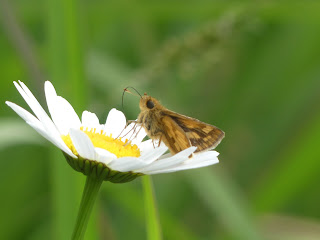Not a Carolina Mantis
While I nodded, nearly napping, suddenly there came a tapping,As of some one gently rapping, rapping at my apartment door.
Okay, I have to confess that my hearing is not good enough to have heard this guy "tapping, gently rapping" on my door. It wasn't until I went outside that I noticed my visitor.
Probably because of the light in the doorway, my apartment door is a fairly popular spot for moths, mayflies, and various other nocturnal insects. This is bound to attract predators like the (relatively) large mantises down to small jumping spiders. I suspect this fella had staked out the area in hopes of making a meal of my smaller arthropod visitors.
When trying to get an ID, I initially went with iNaturalist's 1st suggestion, a Carolina Mantis. But then I read that the wings of the Carolina Mantis only go about 2/3 of the way down its abdomen, which is obviously not the case with this individual.
That leaves the 3 usual suspects:
- European Mantis - Generally bigger than the Carolinas, but generally smaller than the Chinese or Narrow-winged. They're supposed to have either a black or an black-around-white circle in the inside of their front legs.
- Chinese Mantis - Co-biggest of the mantises likely to be in my area, the Chinese Mantis is supposed to have yellow spots on the inside of its front legs.
- Narrow-winged Mantis - The other co-biggest mantis. They're similar enough to the Chinese Mantis that it's no surprise they're related. They're supposed to have orange spots on the inside of their front legs.
Unfortunately mantises naturally keep their front legs fairly close together, at least when they're at rest, making it difficult to "spot the spots". One reason I'm suspicious it's in the tenodera genus is because the egg casings (oothecae, pronounced like OH-uh-THEE-kuh) look more like that of the Chinese/Narrow-winged Mantises.
 |
| September 4, 2022 at Sunny Slope Road Photo 238964960, (c) jpviolette, some rights reserved (CC BY-NC) |



Comments
Post a Comment